

ROBERT LONGO. SYLVAIN GRANJON. JELLE MARTENS. SHIRIN NESHAT. THOMAS BARBEY. JAN HENDRIX. HERBERT BAYER. GLENN BUSCH. ROBERT FRANK. Robert Frank's fine flatulent black joke on American politics can be read as either farce or anguished protest.
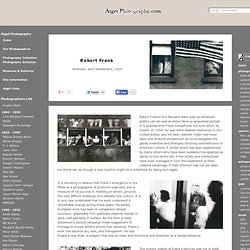
It is possible that Frank himself was not sure which he meant. In 1956, he was still a relative newcomer to the United States, and his basic reaction might well have been one of dumb amazement as he investigated the gaudy insanities and strangely touching contradictions of American culture. A similar shock has been experienced by many others who have been suddenly transplanted as adults to this exotic soil.
A few artists and intellectuals have even managed to turn the experience to their creative advantage, if their direction had not yet been too firmly set, as though a new country might be a substitute for being born again. It is tempting to believe that Frank's emergence in the fifties as a photographer of profound originality was a measure of his success in meeting on artistic grounds the very difficult challenge of a radically new culture. From "Looking at Photographs. ALEK LINDUS.
KATIE WOOD. ROBBIE COOPER. JOHN BALDESSARI. INGE MORATH. JOSH SOMMERS. JOACHIM SCHMID. From Photogenic Drafts, 1991 By Stephen Bull, Essay included in Vigovisións.
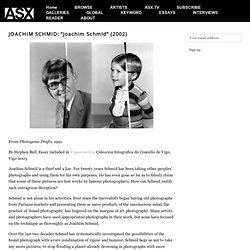
Colección fotográfica do Concello de Vigo, Vigo 2003 Joachim Schmid is a thief and a liar. For twenty years Schmid has been taking other peoples’ photographs and using them for his own purposes. He has even gone so far as to falsely claim that some of these pictures are lost works by famous photographers. JOANNA BRAITHWAITE. View Exhibited Artist Profile The ‘sitters’ in Joanna Braithwaite’s portraits in her exhibition “Goes Without Saying” stare out at the viewer with expressions that range from haughty self-importance (Luminary) to bemused resignation (As Luck Would Have it).
Each creature in Braithwaite’s menagerie is bedecked with accessories that suit their station in life. The melancholic air of the Huia is enhanced by Victorian mourning brooches; with betting slips tucked into their tweed hats, knowing equine glances suggest that the horses have had the inside running all along. The heroism of "Private Simpson and his little beast” (1) on the beaches of Gallipoli is part of ANZAC history and with Silent Partner Braithwaite acknowledges the unnamed animal.
Her donkey, complete with medic’s “slouch hat,” gazes out of the painting with quiet dignity. 1. Selected Works Background. JOHN STEZAKER. Born 1949, in Worcester, UK Lives and works in London, UK 2017 Whitworth Art Gallery, Manchester, UK (forthcoming) Paul Nash and the Uncanny Landscape: An Exhibition Curated by John Stezaker, York Art Gallery, York, UK (forthcoming) Lost World, City Gallery Wellington, Wellington, New Zealand (forthcoming) John Stezaker: Horse, Ikon Gallery, Birmingham, UK.

JOHN DIVOLA. ADAM KRAWESKY. Adam Krawesky started photographing people on the streets of Toronto in the summer of 2002.
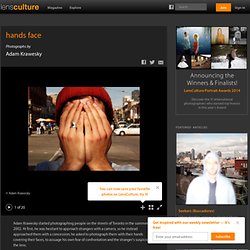
At first, he was hesitant to approach strangers with a camera, so he instead approached them with a concession; he asked to photograph them with their hands covering their faces, to assuage his own fear of confrontation and the stranger's suspicion of the lens. The result, in this brief but telling body of work, are portraits of people with hands that can't lie, of fashions and clothing that do not deceive, of hairstyles, hats and the ornamentation of jewelry, of surroundings and backgrounds that inform and color the character of their primary subjects. What I notice is the truth that comes through from the hands and the postures of the people behind them.
The play-acting of hiding reveals more than a common portrait might ever reveal. ALEX ROSE. ADAM FUSS. Adam Fuss uses early photographic techniques, such as photograms and dauguerrotypes, to create evocative and enigmatic images that explore the mystery, complexity and transience of life.
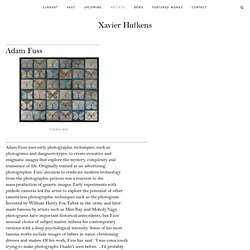
Originally trained as an advertising photographer, Fuss’ decision to eradicate modern technology from the photographic process was a reaction to the mass-production of generic images. Early experiments with pinhole cameras led the artist to explore the potential of other camera-less photographic techniques such as the photogram. KATHY B. SHAPIRO. MELINDA GIBSON. It’s hard to ignore a statement like: “I am interested in the changing perspectives of the photographic medium, how images are viewed and understood through the technological advances in photography and the help and hindrances this begins forth into our contemporary culture.”
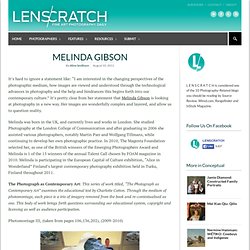
It’s pretty clear from her statement that Melinda Gibson is looking at photography in a new way. Her images are wonderfully complex and layered, and allow us to question reality. Melinda was born in the UK, and currently lives and works in London. ANDREAS GURSKY. ROBERT SCHLAUG. ALEXIS HUNTER. NAN GOLDIN. Shape Shifting 2 2010 100 x 150 cm edition of 3 The Lonely Tree, Sweden 2008 100 x 150 cm edition of 3 Ava Twirling, NYC 2007 Cibachrome Print 76 x 102 cm edition of 15.
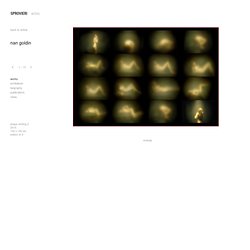
MYOUNG HO LEE. Myoung Ho Lee’s photos use a complicated process to create a simple image: trees separated from their surroundings, hinting at the world beyond. In this series, “TREE,” the “photography-act” is more than a click. MARCEL CHRIST. ALMA HASER. KATE WOODS. LUCAS SIMEOS. LINDA ALTERWITZ. KYLE THOMPSON. ABIGAIL MCGUANE.